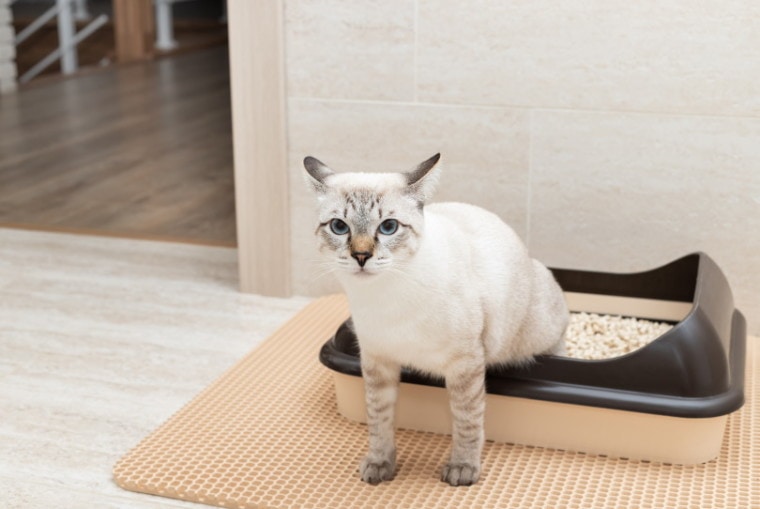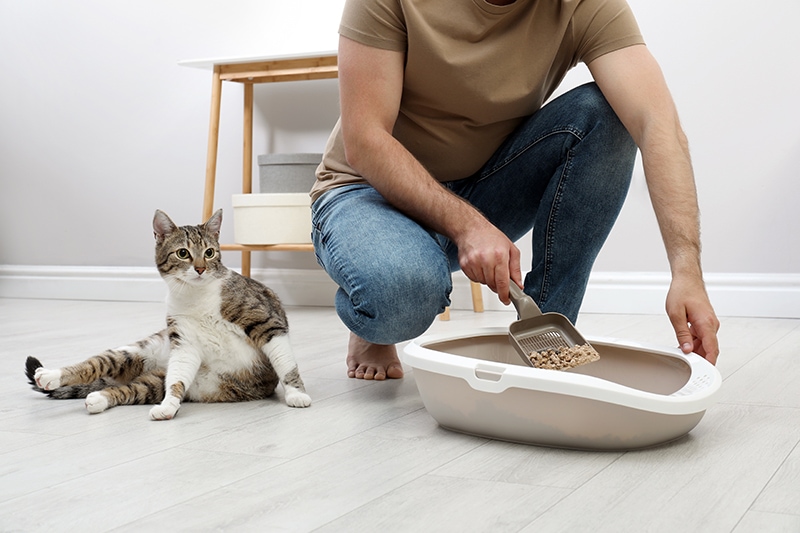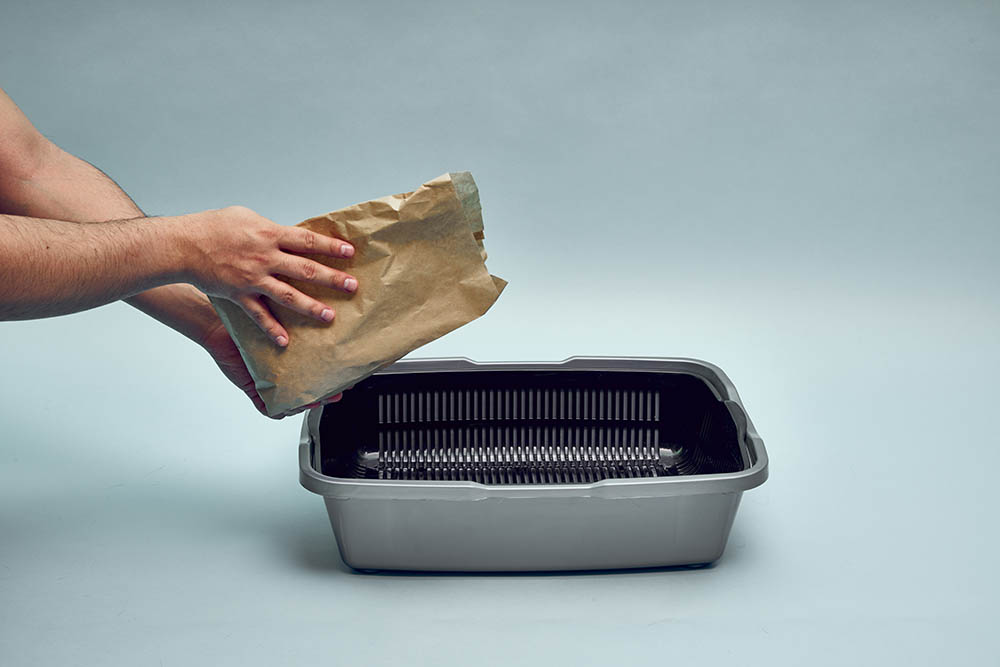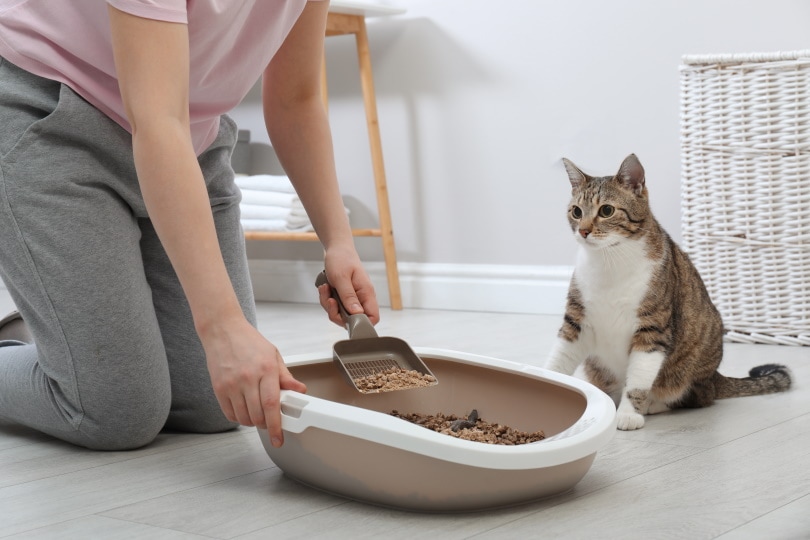
Sometimes, it seems like having a cat that uses a litter box is so much simpler than having to take a dog for a walk to make sure it gets to potty. After all, all a litter box requires is a few minutes of your time every day to keep it clean and acceptable to your cat. However, anyone who’s had a cat for more than about 35 seconds knows that it isn’t really that simple. Cats are fussy when it comes to their litter box, and it’s extremely common for cats to go outside of the box.
It can be frustrating and difficult trying to pinpoint a problem and then remedying it. This is especially true when your cat uses the box properly some of the time, but not all the time. If your cat pees in the box but poops on the floor, keep reading for more information on why they do this and what to do about it.
 Why Do Cats Go Outside of the Litter Box?
Why Do Cats Go Outside of the Litter Box?

There are a million reasons that cats go outside of the box, honestly. Maybe they don’t like the texture or smell of the litter you’re using, or maybe they’re sick and can’t make it to the box. Maybe it’s just Mercury in retrograde or something that’s causing your cat to go outside of the box.
Most of the time, when cats go outside the box, it’s to pee, but they continue to poop in the box. This is common with intact male cats, female cats in season, and cats with urinary tract infections. But if your cat is pooping outside the box but peeing in the box, what does it mean? Well, it could be something as simple as an issue with the litter or the box itself.
If there’s a medical issue with your cat that has been evaluated but they’re still going out of the box, it could be behavioral. One of the big causes of this type of behavior is negative associations. If your cat has had chronic constipation, an infected anal gland, or something else that has made pooping uncomfortable, then your cat may have begun associating the box with pain and discomfort. This means that, in their cat brain, pooping somewhere that isn’t where they associate pain will ensure they don’t have pain.
The 8 Ways to Help Your Cat to Poop In The Litter Box
1. Talk to Your Vet
If your cat is not properly using the litter box, a vet visit is almost always the place to start. Your vet will be able to rule out medical issues that may be causing your cat’s litter box problems. Sometimes, once a medical issue is resolved, your cat will go back to using the box properly. Sometimes, time, retraining, medications, and other interventions are necessary to get your cat back into the habit of pooping in the litter box.

2. Make Necessary Changes
If there is a physical or mental issue with your cat that the vet discovered, it’s important to follow treatment recommendations. Cats with megacolon or chronic constipation may require a diet change to ensure they aren’t struggling to poop. If your cat is anxious or depressed, a short or long-term medication may be necessary to help normalize your cat’s mood and behaviors. There are multiple interventions your vet may recommend, so make sure you make whatever changes you and your vet discuss and deem necessary.
3. Clean the Box
Cleaning the litter box is one of the least desirable chores in the whole house, but it is necessary to maintain health and hygiene, as well as keep your cat happy and comfortable. After all, you wouldn’t want to keep having to use a dirty toilet that you couldn’t flush! Emptying the solid waste from the litter box at least once per day is typically adequate. Many people don’t realize that the whole box needs regular cleaning, though. At least once a month you should be fully emptying the litter box, cleaning and disinfecting it, and replacing all the old litter with new, clean litter.
Wondering whether an enzymatic spray or deodorizing powder is better at fighting pet odors? Compare Hepper's Pet Stain & Odor Eliminator Spray to their Litter Deodorizer Powder to see which product is best for your deodorizing needs.
 |
 |
|
|---|---|---|
| Hepper Advanced Bio-Enzyme Pet Stain & Odor Eliminator Spray | Hepper Advanced Bio-enzyme Deodorizer & Litter Additive | |
| Eliminates smells |
Eliminates smells:
|
Eliminates smells:
|
| Removes stains |
Removes stains:
|
Removes stains:
|
| Powdered/dry form |
Powdered/dry form:
|
Powdered/dry form:
|
| Liquid/wet form |
Liquid/wet form:
|
Liquid/wet form:
|
| Works on a variety of surfaces |
Works on a variety of surfaces:
|
Works on a variety of surfaces:
|
| Works inside your cat's litter |
Works inside your cat's litter:
|
Works inside your cat's litter:
|
At Pet Keen, we’ve admired Hepper for many years, and decided to take a controlling ownership interest so that we could benefit from the outstanding products of this cool cat company!
4. Try Different Litter
This is an easy one if you have recently switched the litter. You may just need to switch back to the old litter if possible. Some cats will tire of a particular litter over time, potentially even for no reason. Your cat may just wake up one day and decide he doesn’t like how the litter covers his poop, so he just starts pooping on the floor. Obviously, there are notable differences between urine and feces, and even cats are aware of this. Your cat’s litter may behave a certain way with urine that isn’t replicated with feces, which may become bothersome to your cat.
5. Try a Different Litter Box
Just like the litter issue, your cat may just not like the litter box you’ve offered. Some cats have preferences for the shape of the box, while other cats may refuse to use a covered litter box. You want to try to find a litter box that meets your cats’ needs while still allowing you to keep your home clean and sanitary.

6. Add Another Litter Box
Do you know the rule of how many litter boxes you should have? The general rule of thumb is a litter box per cat plus one extra. This means that if you only have one cat, you should still have two boxes. Some cats simply don’t want to poop in the same place they pee. Providing an additional litter box in your home will provide your cat with an extra option, encouraging them to use the litter box for both pee and poop.
7. Improve the Environment
Cats can be kind of funny when it comes to litter box use, as we’ve already covered. One thing you may not have considered is the environment in which your cat’s litter box is located. Is it in a busy part of your home that is usually noisy? Is it located in your laundry room where the dryer is typically running? It’s possible that your cat is content to pee in the box no matter where it’s located because they can jump in, pee quickly, then go about their day. Pooping can take a little bit longer and may require more “focus.” For this task, your cat may prefer a quieter, more private location.

8. Make Sure Your Cat Has Access
While this might sound like a no-brainer, it’s important that your cat always has access to a litter box. If your cat’s litter box is located in a bathroom, for example, he may not have access to the litter box anytime someone is using the bathroom or leaves the door shut. Litter boxes in garages and mudrooms may also get closed off from your cat. If there are other pets, people, or items in the home that frighten your cat, then he may not make it to the box if he may have to pass something that scares him to get there. Make sure that no matter what, your cat has safe access to a litter box.
 In Conclusion
In Conclusion
There are a lot of reasons your cat may be pooping on the floor but peeing in the box. Some of them are an easy fix, like changing the litter or treating an infection. Other interventions may be more time consuming and may require multiple attempts on your end to determine the issue and correct it. Carefully monitoring your cat’s behavior and reporting unusual occurrences, like pooping on the floor, to your vet will help your vet stay updated on your cat’s health status and help you find solutions to correcting inappropriate behaviors, no matter the cause.
You may also be interested in:
- Cat Not Covering Its Poop? 7 Reasons Why (& How to Help)
- Do Cats Pee and Poop at the Same Time? What’s Normal?
Featured Image Credit: Mila Naumova, Shutterstock

 Why Do Cats Go Outside of the Litter Box?
Why Do Cats Go Outside of the Litter Box?




